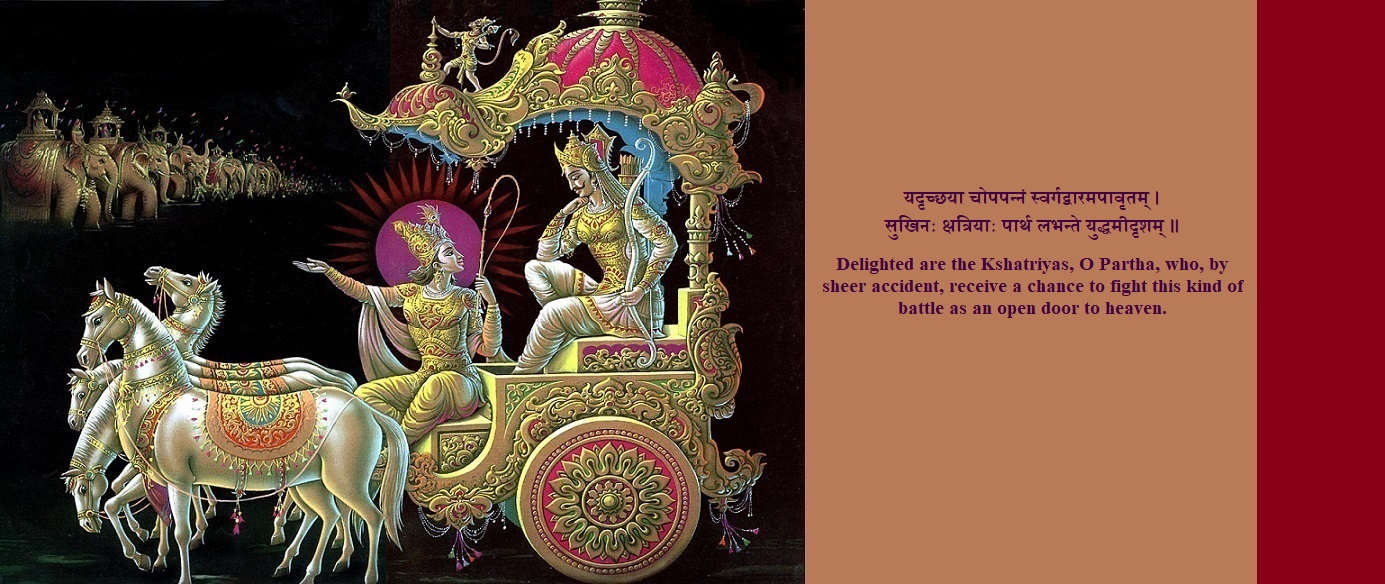Swami Nirmalānanda Giri on The Gita Verse1
(As explained by Swamiji in a discourse introducing the philosophy of the Bhagavad Gita)

Swami Nirmalānda Giri Mahārāj*
In Swamiji’s view, implicit in Dhritarāshṭra’s simple question are the following four different questions:
- In (acting as) dharma-śarīra, what did my sons (Duryodhana and others) do after assembling on the battlefield? [actions under the influence of absolute dharma ]
[Dharma-kshetre samavetāḥ mamakāḥ kim akurvata? (धर्मक्षेत्रे समवेताः मामकाः किम् अकुर्वत)]
- In (acting as) karma śarīra, what did my battle-ready sons do? [actions of relativistic dharma]
[Kuru-kshetre yuyutsavaḥ mamakāḥ kim akurvata? (कुरुक्षेत्रे युयुत्सवः मामकाः किम् अकुर्वत)]
- In (acting as) dharma-śarīra, what did the sons of Pāṇḍu do after assembling on the battlefield? [actions under the influence of absolute dharma ]
[Dharma-kshetre samavetāḥ Pāṇḍavāḥ kim akurvata? (धर्मक्षेत्रे समवेताः पाण्डवाः किम् अकुर्वत)]
- In (acting as) karma śarīra, what activities did the battle-ready Pāṇḍvas perform? [actions of relativistic dharma]
[Kuru-kshetre yuyutsavaḥ Pāṇḍavāḥ kim akurvata? (कुरुक्षेत्रे युयुत्सवः पाण्डवाः किम् अकुर्वत)]
From Dhritarāshṭra’s questions, it is evident that he can very well discriminate between dharma and adharma, good and bad. He was curious to know both the noble and ignoble activities carried out on the two sides of the battlefield. The blind King, for a moment, would have experienced the influence of dharma-śarīra himself. None other than Vyāsa reminded him of the consequences of a war. Vidura, his wise younger brother, advised him of dharma many times. Vidura once invited Sage Sanatsujāta to give Dhritarāshṭra lessons in Brahma-vidya (the Science of the Absolute). The knowledgeable King, at a self-illumined moment, might have thought that his sons and the Pāṇḍavas would agree to call off the battle. Bhīshma’s fall shattered even his last glimmer of hope. He believed that by the patriarch’s grace, he and his sons enjoyed sovereignty. When no hope left, he wondered why the dharma-śarīra of the fighting Kurus did not wake up!
In the original question, we have seen Dhritarāshṭra asking Sañjaya for a detailed description of the first ten days of the war. Looking at the same question from Swamiji’s angle, we realize it provides ample room for the entire Science of the Absolute (Brahma-vidya)!
[*Swami Nirmalānda Giri Mahārāj was a multi-talented genius. He was a consummate Ayurvedic physician who followed the traditions of Charaka and Suśruta. He devoted most of his time in giving great solace to many, many terminally ill people who had no other treatment options available; and the Swami cured many of them to live long, free of pain. Swamiji was a scholar in the Sanskrit language, and a Vedantin of rare wisdom that the twenty-first century witnessed.]
[ To visit the Bhagavad Gita Self-Study page, click/tap on this link: Bhagavad Gita Svādhyāya]
---------------





Leave a comment